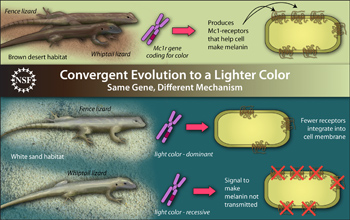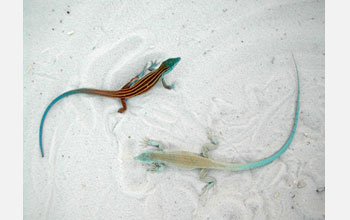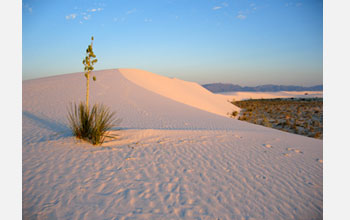All Images
News Release 09-244
Looks Can Be Deceiving
Lizards acquire the same camouflaging adaptation in different ways
This material is available primarily for archival purposes. Telephone numbers or other contact information may be out of date; please see current contact information at media contacts.

The whiptail and fence lizards are dark-colored on dark soil, however when found on white sand, they exhibit a light skin color that helps protect them from predators. It is a case of convergent evolution involving the same Mc1r gene coding for color. In the dark ancestral lizards, the gene codes for Mc1-receptors that help cells called melanocytes make the melanin that makes the animal dark. In the white-sand-dwelling fence lizard, one copy of the mutation is sufficient to cause fewer Mc1-receptors to integrate into cell membranes, therefore resulting in a lighter color. In the whiptail lizards, the mutation is recessive and requires two copies of the gene. This combination does not affect the number of receptors integrated into cell membranes, but adversely affects their ability to transmit signal--arriving at the same result on the macro level: a lighter lizard.
Credit: Zina Deretsky, National Science Foundation
Download the high-resolution JPG version of the image. (623 KB)
Use your mouse to right-click (Mac users may need to Ctrl-click) the link above and choose the option that will save the file or target to your computer.

Lizard species that exhibit rapid adaptation to White Sands, New Mexico.
Credit: Erica Bree Rosenblum, University of Idaho
Download the high-resolution JPG version of the image. (1.1 MB)
Use your mouse to right-click (Mac users may need to Ctrl-click) the link above and choose the option that will save the file or target to your computer.

The gypsum sand dunes of White Sands, New Mexico are a dramatic landscape and a unique environment to observe "evolution in action".
Credit: Erica Bree Rosenblum, University of Idaho
Download the high-resolution JPG version of the image. (3.6 MB)
Use your mouse to right-click (Mac users may need to Ctrl-click) the link above and choose the option that will save the file or target to your computer.


